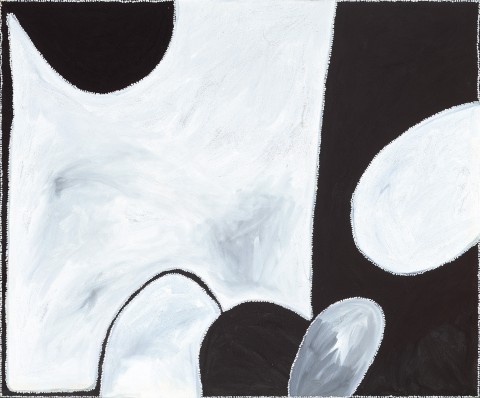MENDOOWOORRJI – MEDICINE POCKET, 2005
PADDY NYUNKUNY BEDFORD
ochres and pigments with synthetic binder on linen
150.0 x 180.0 cm
signed with initials verso: PB
bears inscription verso: date and Jirrawun Arts cat. PB8-2005-234
Jirrawun Arts, Kununurra, Western Australia
The Laverty Collection, Sydney, acquired from the above in August 2005
Paddy Bedford, Museum of Contemporary Art, Sydney, 6 December 2006 – 15 April 2007, and touring, Art Gallery of Western Australia, Perth, 12 May – 22 July 2007; Bendigo Art Gallery, Victoria, 11 August – 16 September 2007; University Art Museum, University of Queensland, Brisbane, 16 November 2007 – 1 March 2008
Storer, R., Paddy Bedford, Museum of Contemporary Art, Sydney, 2006, pp. 114 (illus.), 158
Beyond Sacred: Australian Aboriginal Art: The Collection of Colin and Elizabeth Laverty, Hardie Grant Books, Melbourne, 2008, pp. 233 (illus.), 343
Beyond Sacred: Australian Aboriginal Art: The Collection of Colin and Elizabeth Laverty, edition II, Kleimeyer Industries Pty Ltd, Melbourne, 2011, pp. 246, 247 (illus.), 394
Crafting his own unique representations of country, the paintings of Paddy Bedford evoke rocky escarpments, rivers and other amorphous features of the Kimberley landscape, whilst at the same time containing a learned and poetical knowledge of the land and its creation stories. His formal language is characterised by a symbiotic relationship between bold forms and an elegant, balanced composition. While Bedford’s earlier work engaged the use of natural ochres to depict his environment, his later work employed a more restrained and pared-back palette, initially using only black and white, but later incorporating grey and pink washes, applied to canvas before the previously administered layer of paint had dried, a process known as ‘wet on wet’.
Paddy Bedford (c.1922 – 2007), also known as Goowoomji-Nyunkuny in his own Gija language, is one of the most important Indigenous Australian artists. Painting his first works on left-over building materials in 1998, aged 75, he soon became recognised as an innovator and influential artist through his unique depictions of East Kimberley history, and for evolving the artistic tradition forged earlier by Rover Thomas and Paddy Jaminji.
Mendoowoorrji – Medicine Pocket, 2005 refers to the stretch of hills between Thoonbi and Thoowoonggoonarrin, to the south-east of Bedford Downs. Medicine Pocket was an important camping area pre-colonisation because of its ‘living water’. This region is replete with brooks and waterways flowing through open land and bordered by hills. Like so much of his work, our painting conveys Bedford’s intricate knowledge of his country, its features, topography, and sacred narratives. This land belongs to the artist’s mother’s dreaming, where in mythological times two men fought with sticks and became part of the landscape at Wanggarnaban (the place where Wanggarnal the crow camped, when she was a woman in the dreaming or Ngarranggarni in gija language). Bedford recalled ‘Mendoowoorr country is not far, the country they call Mendoowoorrji. My uncles (my mother’s brothers) were all Mendoowoorr country owners. They have all died now. They are all buried now. It is alright, the country belongs to me now. That is why I can paint this country, because of my old people.’1
This painting was purchased by Colin and Liz Laverty directly from Jirrawun Arts, Kununurra in late August 2005 soon after it was finished. Paddy Bedford and Colin and Liz Laverty had formed a strong friendship very early on in the artist’s career, with the Laverty’s acquiring his first four recorded paintings made on discarded scraps of plywood in September 1998. During the following decade they acquired another 35 paintings by the artist, often having the opportunity to purchase works prior to exhibition. Paintings and gouaches by Paddy Bedford held in the Laverty collection have been loaned regularly to survey and other exhibitions featuring Bedford in Australia, and internationally.
In 2006, Paddy Bedford’s oeuvre was honoured with a grand retrospective at the Museum of Contemporary Art in Sydney where this work was displayed. Bedford’s first international retrospective exhibition took place in 2009 at the Museum of Contemporary Aboriginal art in Utrecht, the Netherlands. Since then, his work has been on display at several exhibitions worldwide, including the Metropolitan Museum of Art, New York; the Musée du Quai Branly, Paris; and the Museum Ludwig, Cologne.
1. The artist in conversation with Frances Kofod, in Paddy Bedford, Museum of Contemporary Art, Sydney, 2007, p. 134
CRISPIN GUTTERIDGE
